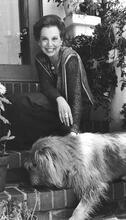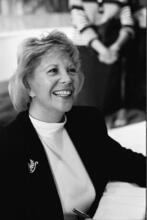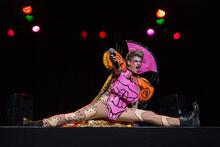Dinah Shore
Singer, actress, and talk show host, Dinah Shore (1917 - 1994), Miami Book Fair International, 1990.
Image courtesy of MDCarchives.
Dinah Shore was one of the top recording artists of the 1940s, with hits like “Baby, It’s Cold Outside,” before starting a new career in the 1970s as a talk show host. When Shore graduated Vanderbilt University in 1938, she traveled to New York and appeared on Eddie Cantor’s radio show for the first time in 1940, the same year her recording of “Yes, My Darling Daughter” sold half a million copies—a combination that launched her career. She hosted radio musical variety shows, made seventy-five hit recordings, and acted in six movies before switching to television. In the 1970s, she had several shows including Dinah's Place and Dinah! (Later Dinah & Friends), In her career, Shore won nine Emmys, a Peabody, and a Golden Globe.
Dinah Shore, the quintessential American girl, was both America’s sweetheart in the 1940s and 1950s and a leading example of an independent woman in the 1970s. Her career spanned over forty years and included stints on the radio and in the movies. Her most enduring legacy, however, is her impressive vocal recordings and television shows.
Early Life
Born in Winchester, Tennessee, on March l, 1917, to Anna (Stein) and Solomon Shore, she was named Frances “Fanny” Rose Stein. Her sister, Bessie, was eight years older. When Fanny was six years old, the family moved to Nashville. Two important childhood experiences affected the person who became the personality called Dinah. First, she suffered an attack of polio when she was eighteen months old, which left her with a paralyzed right leg. Her mother played a crucial role in her rehabilitation, massaging the leg regularly and insisting on a rigorous exercise program. As a result, she overcame the disability and, as a young child, learned to swim, play tennis, and dance ballet. The second major factor was the family’s Jewishness. In Winchester, particularly, the Shores were conspicuously out of place as the only Jewish family in a Protestant environment. Even in Nashville, Jews were a small minority, and Shore noted in early interviews that she felt that she always had to be exemplary in her behavior and outstanding in her performance. When she graduated from Hume Fogg High School in 1934, she was voted “the Best All-Around Girl in the Class.” By that time, she and her father (her mother had died when she was fifteen) lived with her older sister, who was married.
Radio and Singing Career
Shore went to Vanderbilt University, an unusual pathway for a young woman in the 1930s, but appropriate for a middle-class daughter of a businessman who wanted to give his daughter every opportunity for success. Shore majored in sociology at Vanderbilt, where she headed the women’s government club and was president of her sorority. She graduated in 1938. During the summer of 1937, she went to New York City with her sorority sisters and fulfilled an ambition to sing on the radio. After her college graduation, she returned to New York and got a job singing on radio station WNEW. This experience led to others, and in January 1939 she became a singer with the Leo Reisman Orchestra. Though Variety noted her singing, the reviewer was not overly impressed with her pleasant but unexceptional style.
By this time, she called herself “Dinah,” the name of a song she had sung on the radio, and began to enjoy some success. In September 1940, she went on the very popular Eddie Cantor radio show. Cantor later remarked on her hard work, her exceedingly pleasant style, and her easy manner, traits that would be noted throughout her long career. Shore sang on the Cantor show for three years, while also hosting radio musical variety series of her own. In fact, until 1955, she would rarely be off the airwaves for long.
In 1940, her recording of “Yes, My Darling Daughter” sold half a million copies. In 1944, her rendition of “I’ll Walk Alone” was one of the year’s biggest hits. In all, Dinah Shore had seventy-five hit recordings. Her contralto voice conveyed an image of sincerity and goodwill. Her personal appearances during World War II were enthusiastically received, and only Frank Sinatra exceeded her popularity. On December 5, 1943, she married actor George Montgomery. In 1948, she gave birth to a daughter, Melissa Ann.
Television Work
In 1951, she made the transition from radio to television and appeared twice weekly for fifteen minutes each. During this period, she also appeared in six movies, the most notable being Up in Arms with Danny Kaye. Shore did not enjoy moviemaking and did not think she was particularly effective in that medium. She was right. Television turned out to be the perfect medium; the small screen allowed her personal warmth and intimate manner to be showcased. During the history of The Dinah Shore Show, from 1951 to 1956, Shore sang and had guests who performed. In 1956, The Dinah Shore Chevrolet Show, a one-hour weekly musical variety show, came into being, and she became even more famous singing her trademark song: “See the U.S.A. in Your Chevrolet.” The show remained high in the ratings for seven seasons.
Shore’s marriage to George Montgomery ended in divorce in May 1962, and she decided to retire temporarily from a weekly television show so that she could spend more time with her children. Besides her daughter, she had adopted a son, John David, in 1954. Shore moved her family from Beverly Hills to Palm Springs, California, and though she appeared occasionally in concerts and in Las Vegas, she stayed out of the public eye until 1970, when she returned to a new variety show called Dinah’s Place. This show lasted from 1970 to 1974 and was followed by an afternoon talk show called Dinah! (Later Dinah and Friends) from 1974-1980. On this show, she talked to her guests, shared recipes and cooked with them, and sang. Dinah Shore hosted successful television shows for over twenty years, something of a record in an industry where ratings and profitability often lead to quick series cancellations.
Sponsoring a major women’s golf tournament beginning in the 1980s, Dinah Shore remained active. In 1981, she did a multicity concert tour for the first time in over a decade. Dinah Shore died of ovarian cancer just short of her seventy-seventh birthday, on February 24, 1994.
Later Years and Legacy
Dinah Shore contributed to America’s entertainment for over forty years. During wartime, she projected an image of home, love, and family for the American soldiers overseas and for their families at home. In early television, she displayed great skill in the very American format of a variety show, encouraging her guests and introducing new talent. As a talk show hostess in the 1970s, she allowed her guests to share their views in a nonconfrontational setting. While some television critics of the 1970s compared her unfavorably to the more combative Phil Donahue, her supporters pointed out the need for civility in an increasingly tendentious and hostile world.
Dinah Shore was the perfect transitional figure for women in changing times. She was independent, intelligent, self-confident, and accomplished while, at the same time, she projected an image of warmth and femininity. She matured nicely on television, proving to older women that aging was not a curse or a disease. Thanks to audio and video recordings, her legacy continues.
Cassidy, Bruce. Dinah! A Biography (1979).
Current Biography (1966): 376–378, and (1994): 60.
“Dinah’s Showcase.” Newsweek (December 8, 1952): 54.
Holden, Stephen. Obituary. NYTimes, February 25, 1994, B16.
Hubler, Richard G. “The Indestructible Dinah.” Coronet 47 (November 1959): 143–148.
“Is There Anyone Finah?” Time (December 16, 1957): 60.
Johnson, Grady. “Dinah Shore Story.” Coronet 33 (November 1952): 92–97.
Morehead, A. “For Fifteen Years Nobody Finer.” Cosmopolitan (August 1955): 44–49.
“It’s Tough To Be a Woman.” TV Guide (December 15, 1956): 13.
Stewart, Phyllis. “Dinah Shore Is Back on the Road Doing What She Loves to Do Best.” Chicago Sun-Times, May 17, 1981, 10.
“Ten Years for Dinah.” TV Guide (October l, 1960).








